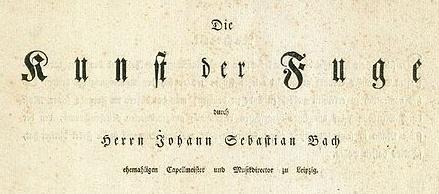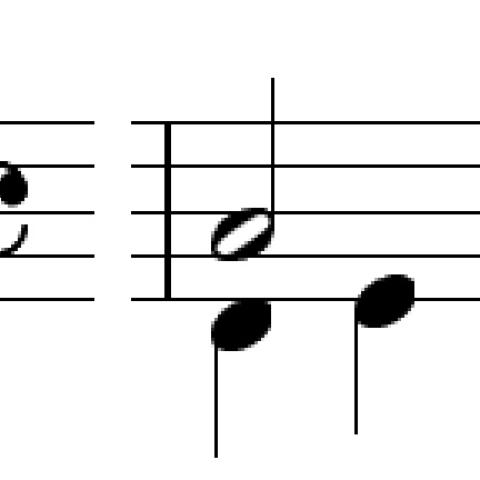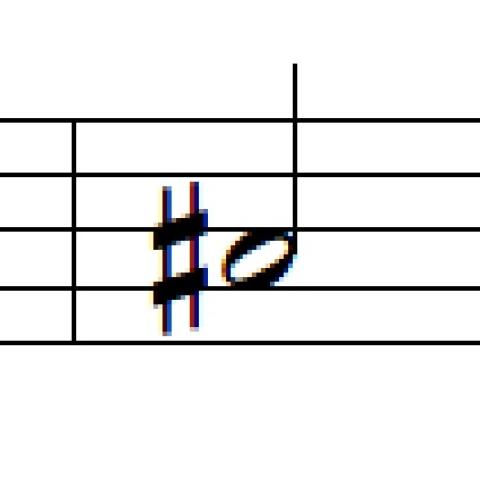
The Art of the Fugue, part 6
I recently had a concert performance anxiety dream. This one was specifically about The Art of the Fugue, and it followed a common pattern: I was aware I was to perform the piece, and I sat down at the organ, but when I looked at the score, I realized that I had never seen the music before. I started to panic, but also to try to scheme: could I get away with sight-reading this? How slow could I play it without giving away what was going on? Could I leave out the hardest bits? I remember looking around hoping to see something happening that would force the concert to be abruptly canceled. The music on the page was not actually The Art of the Fugue. It was dense, chordal, and chromatic. The typeface looked like something French from the late nineteenth century. But within the dream I accepted that this was indeed the work that I was supposed to be playing. I had just somehow neglected to learn it.
I have this kind of dream once or twice a year, but I am pretty sure that these dreams usually involve playing at someone else’s behest, in chamber music or in a church service, not solo performance. My Art of the Fugue project is something that is being carried out only at my own behest. My decision to do it is a choice to focus on something that is specifically important to me and that I am utterly convinced I can only do well if I am very committed to doing it the way I want it to be done.
So why the dream? My only thought so far is that I am trying to remind myself that I should really learn the thing! There are always traps in any project, and maybe the trap with this one is that my sense of “ownership” over this work, my awareness that I have been studying it and interacting with it for nearly fifty years, my experience of being comfortable with it at a conceptual level will disguise how hard it is to play and lead me into complacency about the business of learning the notes. Maybe that is what the dream was about, or maybe not. Yet, any interpretation of a dream that reminds me to work as hard as I can to become as certain of the notes as possible is worth paying attention to!
Connections
The connection between the sense of understanding, inner commitment, ownership, and the nitty-gritty practical learning of a piece is a complicated one. At one level, there is the fact that, for almost everyone, focus and concentration are easier and more successful working on something we love than on something that we do not care about, or at least not very much. This is why I want students who endeavor to become more accomplished players to work on music they care about. The translation of time and effort into growth as a player is most efficient this way. Students do not know what music is out there as well as I do or another teacher does. The process of helping them to explore things that they do not know interacts in complicated ways with the goal of working on music they love.
Yet, I am wondering about something deeper. If one feels a deep bond with the music one is working on, what dangers does that invite? I believe there is a risk of assuming that the bond with a piece or a composer or a repertoire is in itself enough to make something come across to listeners. If I feel something while I am playing and listening, am I interpreting the music a certain way because of my love of the music? Is this hiding the necessity of doing something interpretively from me?
Overall structure of The Art of the Fugue
I now turn to some thoughts about the overall structure of The Art of the Fugue. There are two salient facts I would like to discuss. The first is that one of the movements is incomplete—the one that most of us take to be the final movement. Second, that there is some uncertainty as to the order in which Bach intended the movements to be played. There has been a lot of serious, thorough, and fascinating scholarship about both of these matters, each of which has a different set of interactions with performance. Regarding the final movement, there is the question of whether to play it as it has come down to us, breaking off abruptly, or to alter it in some way, either by completing it or by ending it at an earlier point than the break-off. As a set of choices this is probably more about philosophy than about scholarship or research. Scholarship, research, and analysis can, for those who wish to perform a completed version of the piece, elucidate different possibilities for that completion. There is also, however, the question of whether to play it at all. This is a matter that has to be addressed by a combination of scholarship and philosophy. It used to be fairly common for performers or scholars to entertain the possibility that this movement was actually never meant to be part of this work. I believe this is a rarely held view nowadays, and indeed the musical connections between this movement and the rest of the work are convincingly strong. To be fair, though, there are one or two quite recent recordings of the work that omit the long, unfinished fugue.
Anyone who sets out to perform The Art of the Fugue has perforce to end up making a decision about an order in which to play the pieces. And, speaking of recording, I have just completed a quick and random survey of a dozen or so CDs of the work, and no two recordings present the movements in the same order! This includes performances on organ, harpsichord, piano, and by chamber ensembles, such as saxophone ensembles, consorts of viols, and so on. These are mostly recent recordings, subsequent to the burgeoning of Art of the Fugue scholarship that we have seen over the last few decades.
(Further regarding recording: nowadays it is easy to set up a recording of the piece with each movement in a separate file, and with playing order to be determined by the listener. This could be as a set order or as a random “shuffle.” So I should say that any performance of The Art of the Fugue presupposes a choice by the performer about movement order. Only a live performance does so of necessity.)
There are two underlying causes of uncertainty about movement order. The first is there are two primary sources for the piece: a manuscript of most of the movements in Bach’s own hand from the mid-1740s, and the edition published in 1751 by Bach’s heirs. These sources have different numbers of movements and are presented in different order. The second source of uncertainty is we do not know how much input J. S. Bach himself had in the preparation of the printed edition. Therefore we do not know that he had signed off on the order represented there.
For example, it is possible for a performer to assume that, since the people who finished the preparation of the 1751 edition were close to J. S. Bach and worked with him directly on at least much of the project, the order that they created is probably the correct order. But this would be at best just an assumption, and there is a significant amount of scholarship to call it into question. A further complication is that the published edition contains elements that almost everyone agrees are not really part of The Art of the Fugue at all, at least not part of the integral structure of the work as a whole. For instance, there are alternate versions of two of the movements and a chorale prelude, the latter manifestly added to the end of the publication as a kind of compensation for its incompleteness and a memorial to the composer. I have never encountered or even heard rumored any performance of literally every note in that original edition in the order in which those notes are found there. So what were these early editors up to, and what did or didn’t they understand about the composer’s intentions?
You will probably not be surprised to read that we cannot answer that question. As I said, there is a lot of good scholarship on the matter, but that scholarship is often in disagreement. Every argument rests on assumptions, and while many of those assumptions seem sound, none of them seem rock-solid certain.
As a performer I must come up with an order. I notice, reading my 1985 program notes, that I then completely accepted the order that I had grown up with. This is the order that Helmut Walcha used in his recording, and I used the same order. This is almost the same as the order used by the early twentieth-century scholar Wolfgang Graeser, who is credited with rediscovering The Art of the Fugue, and whose edition was used as the basis for the first known public performance of the work, which took place in 1927. As best I remember, I did not particularly know at the time there were issues about movement order, since much of the scholarship on the matter has been carried out since then.
I found considerable structural logic in the shape of the piece with this order of movements. For example, I considered the placement of the group of four canons, with their two-voice and therefore relatively light texture right after the dense and complex Contrapunctus XI, to be aesthetically and structurally significant. However, the canons as a group are not placed after Contrapunctus XI in either original source, and they are differently placed in the two sources. Other performers find logic in spreading them out around the other mostly four-voice fugal contrapuncti. This uses the lighter texture to define groupings in the successive fugal pieces. Some performers place them after the long unfinished fugue, displacing it as the ending, and instead ending the work using the lighter textures to create a relaxed sort of coda.
I also found logic in the gradual introduction of the B-A-C-H motif, successively more open and clear in Contrapuncti IV, VIII, XI, and XVIII. Likewise, I find logic in the immediacy of the motion from the flourish ending Contrapunctus XVI—the four-voice mirror fugue—to the opening subject of Contrapunctus XVIII of which it is a very close pre-echo. This happens only if the appropriate section of Contrapunctus XVI is the last item before Contrapunctus XVIII. I also found the juxtaposition of Contrapunctus VIII—the first one whose subject opens with an interval smaller than a fourth—and Contrapunctus IX—the first one whose subject opens with an interval greater than a fifth—to be meaningful. This is only a juxtaposition if those two movements are indeed next to each other.
There are a number of questions that arise out of this complicated picture. If I see a convincing overall structure in this piece with a particular movement order, does that mean that this is likely to be the “correct” order, the order that the composer had in mind? (I will answer this one: no.) Or am I simply imposing that sense of structure because I am accustomed to that order and fondly want to believe the piece has a meaningful overarching shape? (Maybe.) Is it possible that if we really knew for sure what order Bach had in mind we would see that order gave to the work an even more compelling overall shape than we experience now?
Musical entities that are not just clearly one unit have a variety of shapes. To stick with Bach for the moment, The Well-Tempered Clavier is one thing (a collection of completely separate pieces, but ones constructed along similar lines to one another); a suite or partita is something else (a piece clearly intended to have an overall shape, but made up of movements that are in different forms from one another, each of which could stand as a piece in itself); The Goldberg Variations is something completely different yet a piece made up of clearly separate movements, but also with a clear unifying principal among the movements. Das Orgelbüchlein falls into the same category as the WTC. How about Clavierübung III? Unlike all of the above, it gets part of its unified or structured feeling externally, through the associations that we have with the hymns on which the pieces are based. It is also given a circular structure by the prelude at the beginning and the fugue at the end.
Which of all of these would seem very different if the order of the component parts were changed? It would probably depend on the specifics of the changes. For example, if in The Goldberg Variations, the return to the opening “Aria” were taken away from the end and placed somewhere in the middle, that would feel like a drastic change, probably a change for the worse. If the imposing “Variation 16” were moved away from the position that it occupies in the middle of the work that would probably seem odd and weaken the overall shape of the piece. Moving other movements around might make considerably less difference. In Clavierübung III, if the closing fugue were moved into second position right after the prelude, leaving the work to end with the four duets, the structure of the whole would seem radically different. If the four duets were distributed throughout the piece rather than placed in a group at the end that would seem like a real change as well.
In all of these cases we have reason to believe that we know what order Bach intended. With The Art of the Fugue we approach the same sorts of issues from a less anchored place.
I will continue this discussion next month, attempting to tie it in as closely as possible to some of the specific compositional details of The Art of the Fugue and, in turn, to performance as such.
To be continued.





